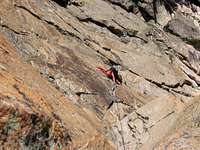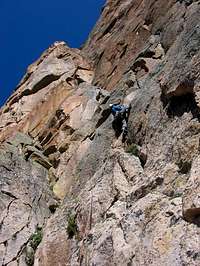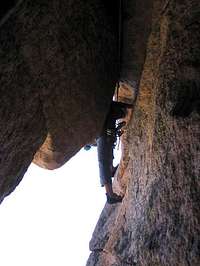|
|
Route |
|---|---|
|
|
44.06850°N / 114.9684°W |
|
|
Technical Rock Climb |
|
|
Most of a day |
|
|
III 5.10 C1 or 5.12- |
|
|
III |
|
|
Approach
Follow the description on the main page to reach the lowest of the Saddleback Lakes at the base of Elephants Perch. The trail puts you on the side of the lakes opposite to the Perch. Cross over to the Perch side above the lowest lakelet. Hike back towards the Perch's SE face aiming for the gully (standard descent route) in the photo. There's a short (~70 foot) low to mid 5th class section at the mouth of the gully (huge chockstones block progress). Either free solo it up (harder than it looks IMHO) the chockstones or do a quick pitch. Hike up the gully above (loose class 2-3) passing another (class 3) set of chockstones shortly thereafter. Above this 2nd "chockstone step" look for the most prominent dihedral (right facing) above you. Continue 100 feet past the dihedral till you can cut back left up easy ledges (class 2-3; aim for large trees) toward the base of the SE face just right of the dihedral above. Approach time from Saddleback Lakes is 20-30 minutes.
Route Description
This is probably the most sustained route we have done up until now in an alpine setting. Pitch after pitch of demanding climbing on some of the most solid granite I have ever seen. The route will work a 5.9 leader nicely and make for one unforgettable outing; the route might also be a memorable adventure for many a 5.10 leader (expecting a quick 5.10- hike-up) as well IMHO. The ratings below come from the topo (Much thanks to John F. of cascadeclimbers.com for emailing me the topo originally); Lopez' guidebook ratings follow the topo (he also includes a good overview photo showing route's general location on The Perch). Route starts almost directly in the fall line (just right a bit) of the dihedral towering above. Note that this area has a very strict fixed anchor ethic. DON'T ADD ANYTHING - NO BOLTS, NO PITONS!!!! The only piece of fixed HW was a big angle on pitch 3 (other than stuck nuts). Also note that these topo ratings have an "old school" flavor.
Pitch 1: 5.9+, 160 feet. Climb the steep face 15-20 feet right of a right-facing dihedral system. You move up, right, and then back left (5.9+, crux) again following intermittent cracks. Pull into a left facing dihedral and climb up towards a small roof with a nice handcrack directly below it. Pull the roof around on the left and mantle up onto a nice belay ledge. Belay on gear. This is the last place to bail on this route without having to leave cams.
Pitch 2: 5.8 C1 or 5.12-, 120 feet. Climb a lower angle dihedral/groove for ~30 feet. Pull a bouldery move left to reach the base of the 5.12- open book. Aid up (straightforward; couple fixed nuts to start with) the small dihedral which changes over from a left facing to a right facing. Belay on a narrow 6-inch stance just before the crack in the dihedral widens to hands. Semi-hanging, gear.
Pitch 3: 5.10, 120 feet. The topo gives this pitch a lower rating (5.9+) than pitch 4. I thought this was the crux pitch and much harder than the next one (which the topo gives 5.10- rating). Climb the crack in the dihedral which goes from decent hands to flaring finger crack (crux of route IMHO). The angle kicks back for the last 20 feet or so. Belay at base of another steep crack section. Uncomfortable, semi-hanging stance on gear. PS: Per AJones who did the route and spoke to the FA-ist, this pitch should be rated 10d.
Pitch 4: 5.10-, 110 feet. I found this pitch to be easier than the previous. Climb up the steep handcrack which narrows to (nice, positive) fingers towards the top. Mantle into the dark chimney and belay. Good stance and gear.
Pitch 5: 5.9+, 70 feet. This is the wildest pitch of the route IMHO. Chimney up (~15 feet; 5.9-ish) to the ceiling and then move back out towards the outside. Enjoy the view of the lower pitches below your feet. Pull out of the chimney to the left (that's climbers' left; 5.9+). Going eases after a few moves. Watch for loose boulders as you top out on the summit ridge.
Descent: Either hike up left (climbers' left) and tag the summit (few hundred feet along summit ridge) or hike down a few hundred feet (class 3) along the summit ridge to the top of the descent gully you see on the right. Hike down gully (passing the base of the route). Make 1 rappel down the face left (that's left as you're descending) of the chockstones.
Essential Gear
Take it for what's it worth - the route was hard for me and all belays are off of gear:
Good selection of small to mid-sized nuts (with a few micros or RP's).
Double Aliens from green to red.
Triple Camalots from #0.75 to #2.
Double #3 Camalots.
Single #3.5 Camalot.
Some optional gear for the short (30-40 foot) aid section if you're not up for 30 feet of 5.12-.
Route Overview
topoWeb Links
(1) Sunrise Book TR from piquaclimber.com.
(2) Nice TR from cc.com.
More when I find them...

















AJones - Nov 11, 2007 6:48 pm - Voted 10/10
3rd pitch harder than 4thAlmost everyone I've discussed this climb with, thinks the 3rd pitch is (considerably) harder than the fourth; including me and my partner who climbed it last summer. We walked in with one of the first ascentionists of the route and were told to expect 10d. Just a heads up.